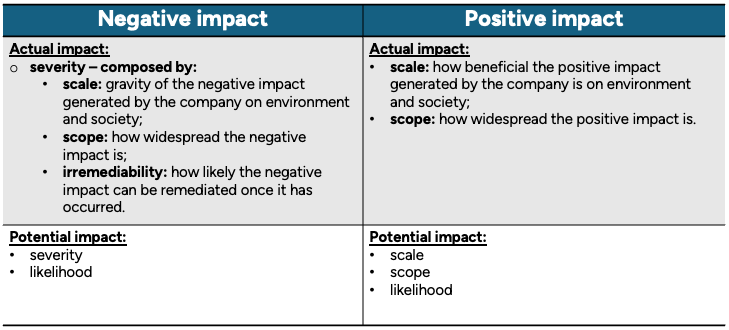Thank you for visiting the Finch & Beak website. Finch & Beak is now part of SLR Consulting, a global organization that supports its clients on setting sustainability strategies and seeing them through to implementation.
This is an exciting time for us, as our team now includes an array of new colleagues who offer advisory and technical skills that are complementary to our own including Climate Resilience & Net Zero, Natural Capital & Biodiversity, Social & Community Impact, and Responsible Sourcing.
We would like to take this opportunity to invite you to check out the SLR website, so you can see the full potential of what we are now able to offer.
Double materiality brings together the concepts of impact materiality and financial materiality. This article will focus on the first, while a forthcoming article will delve deeper into how to quantify financial impacts. For a one-page summary of how to conduct your impact materiality assessment, check out the download of this article (just above this paragraph).
The ESRS do not provide binding processes to assess impact materiality, since there is not a single one-size-fits all process that can suit all the different types of businesses covered by CSRD. However, EFRAG has issued draft guidelines that companies can refer to when developing their own assessment and process.
According to ESRS 1, the different aspects to consider when investigating impact materiality are:

When performing impact materiality assessment, companies may face several challenges. Among these, one of the most difficult to address is related to the evaluation of impacts. Difficulties may arise in terms of:
An example could be the assessment of the impact related to air pollution: accurately evaluating the scale and scope of impact requires stakeholders involved in the assessment to deeply understand the quantity and types of pollutants emitted into the atmosphere. However, quantifying pollutants requires a tailorized assessment and a process to carry them out which can be challenging to implement, requiring time, resources and (external) expertise.
Depending on the stage at which a company is in its sustainability journey, there are different solutions applicable to the quantification of the impacts.
• Implement a due diligence process:
Whether the undertaking is covered by the CSDDD proposal or not, developing and implementing a due diligence process can help to overcome challenges related to quantifying the main impacts in the company’s value chain, as further explored in this article.
• Develop a process for impact assessment:
An impact assessment process can identify, assess, and mitigate negative and positive impacts on the environment and on society. Having this process in place will facilitate the double materiality assessment and will allow a quantification of the impacts generated. Examples of impact assessments are climate-related risks & opportunity assessments incl. scenario analysis (following TCFD recommendations), life cycle assessments, biodiversity assessments, human rights impact assessments.
• Tailor scale and scope:
In case the above-mentioned tools are not an option in the short term, assigning a specific and tailored value to scale and scope is highly recommended. Scale and scope of impacts can indeed vary from company to company based on the location of facilities, the value chain and the business activities and operations. If, for example, the scope of the impact ranges from low to high, an organization may develop a tailored quantitative reference to the scale: low can relate to e.g. 0-10.000 inhabitants affected by the impact and high to e.g. 10 million to 1 billion of inhabitant affected. The same approach may apply to the scale of impact.
• Use external sources and research:
To support the assessment of impacts identified, the consultation of external research, analysis and documents on common sectorial or geographical impacts is also highly relevant to address impact assessment challenges. Examples include the Environmental Performance Index and Labour Rights Index.
Two remarkable examples of processes to identify, assess, and quantify impacts and therefore applicable to impact materiality can be seen at Coca-Cola HBC and Solvay. Coca-Cola HBC has conducted a Biodiversity Impact and Risk Assessment, through which it was able to identify key impacts generated from human activities and their contribution to nature loss. Solvay’s Sustainable Portfolio Management provides information on how Solvay’s products contribute to improving social and environmental performance. This is done by considering the environmental footprint, risks and opportunities related to the product, and the benefits brought by the product in its application.
The actionable tools proposed in this article and the double materiality assessment process as a whole, are not only essential for complying with new ESG regulation but also offer strategic benefits for companies beyond reporting. By adopting a strategic approach to assessing impact materiality, companies can identify and mitigate negative impacts, as well as enhancing positive impacts. This will bring to ultimately improve sustainability performance, strengthen stakeholder relationships, and drive business growth.
Finch & Beak's vision is to create value beyond reporting. We support companies in preparing to comply with upcoming regulation, and moreover to get strategic insights out of your double materiality assessment. If your organization requires support on its double materiality journey, reach out to Johana Schlotter, at johana@finchandbeak.com or call +31 6 28 02 18 80 to discuss how Finch & Beak can support you in meeting your ambitions.
Photo by note thanun via Unsplash.
Sustainability professional aiming to help companies and societies rethink and minimise their impact on the environment. aurora@finchandbeak.com
Finch & Beak
hello@finchandbeak.com
+34 627 788 170